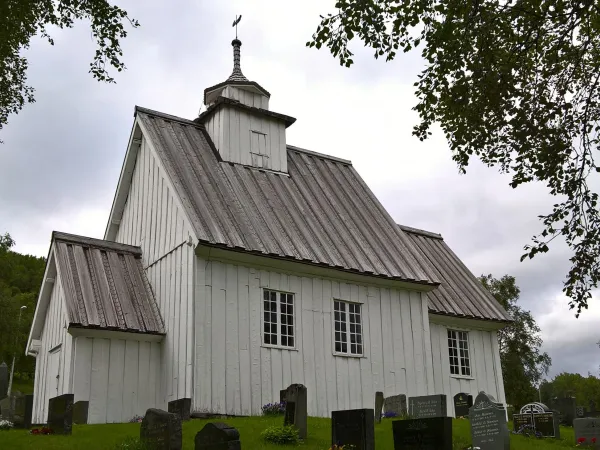
The old Bykle church
As early as 1327, the Pope recorded “Eccl. de Buglum” — Bykle Church — in his annals. We do not know exactly when it was built, but it often took some time before a new church this far north was registered by the Pope. There may have been a church on this site as early as the 13th century, or perhaps even earlier. The outline of a large burial mound above the church suggests that it was built on an old pagan cult site.
Guided tours of the old church are available during the peak summer season (from around Midsummer to the start of the school year). The church is protected and was replaced by a new church nearby in 2004.
Description
About Bykle Church:
The first church in Bykle was likely a stave church. Due to the population decline caused by the Black Death, maintenance was probably minimal for many generations, and after the Reformation, it likely worsened. A letter from 1619 states that Bykle Church “has been abandoned for some years.” The same letter mentions that the church was now to be rebuilt and maintained, following the wishes of the congregation and with the bishop’s permission. Once this was done, the priest would come from Valle to hold mass three times a year.
The current old church, as it stands today, was built around 1620, making it the oldest church in Setesdal. It is built of finely notched round timber with an exterior cladding of white-painted paneling. Some of the timber from the old stave church was reused in the new building, including in the roof structure. The church consists of a small porch, nave, and chancel, but lacks a sacristy. It is one of the smallest churches in the country, only 11 meters long.
Between 1803 and 1806, the church underwent a thorough restoration, giving it its current form. Previously, it had a separate tower at one end, which was replaced by the current roof turret with a bell tower. The galleries on the west and north sides were likely added at this time as well. Despite several major restorations in the 18th and 19th centuries, it is safe to say that Bykle Church is essentially from 1620.
One of the church’s most distinctive features is the rose painting from 1826. The beautiful timber walls have a white base color, over which roses and vines spread. The ceiling is painted like a sky with stars and clouds. From this sky, Christ looks down on the congregation, raising his hands in blessing. The painting was done by Aslak A. Vasshus from Rauland, assisted by Knut Åvoldsson Byklum from Bykle. Traces of older decorations have been uncovered, possibly original, including green vine patterns in the chancel and a king on the chancel beam. The front of the gallery is decorated with carved Olav’s roses, associated with Saint Olav.
The altar and pulpit are Renaissance works from the early 1600s. The altarpiece has an unusual design with a protruding canopy, identical to the old altarpiece in Valle, now housed at the Norwegian Museum of Cultural History. The two main panels depict Jesus carrying the cross and the crucifixion. These paintings are dated to the 18th century. Uncoverings have shown that the images were painted over older motifs, possibly the originals.
The pulpit is built in the same style as the altarpiece and features decoration from around 1700. Three arched panels show the evangelists Mark, Luke, and John with their symbols. Since Matthew is missing, the pulpit must have been altered, possibly during the 19th-century restoration.
The baptismal font is made of wood and shaped like an hourglass, dated to around 1600. The bronze baptismal basin is from the first half of the 1600s. In the chancel hangs a small wall cabinet used to store altar books. The cabinet is dated to the early 1600s, with rose painting from the early 1800s.
There are nine benches on the men's side (south) and seven and a half on the women's side (north). The distance between the rows is 74 cm on the men's side and 65 cm on the women's side. You don’t have to be very tall to struggle with legroom!
In 1683, merchant and judge Laurits Andersen Undal donated the church bell to the Bykle congregation. The bell bears the inscription “Si deus pro nobis, quis contra nos,” which means: “If God is for us, who can be against us?” The bell ringer stands in the aisle of the church and pulls a rope.
It wasn’t until 1989 that Bykle Church received an organ, built by the Swede Nils-Oluf Berg and designed by Ulf Oldaeus. This is a pipe organ with one manual and five stops. The old sung hymn tones, with all their flourishes, lived on in Bykle longer than in most other places.
Welcome to Bykle church, a small gem of church history.
